Adolfo Ruiz Cortines
Adolfo Tomás Ruiz Cortines (Spanish pronunciation: [aˈðolfo ˈrwis koɾˈtines] ⓘ 30 December 1889 – 3 December 1973) was a Mexican politician who served as President of Mexico from 1952 to 1958. A member of the Institutional Revolutionary Party (PRI), he previously served in the Constitutional Army during the Mexican Revolution, as Secretary of the Interior, as Governor of Veracruz, and as a member of the Chamber of Deputies for Veracruz′s 3rd district. During his presidency, which coincided with the Mexican Miracle, women gained the right to vote, and he instigated numerous public health, education, infrastructure, and works projects.
Adolfo Ruiz Cortines | |
|---|---|
.jpg.webp) | |
| 54th President of Mexico | |
| In office 1 December 1952 – 30 November 1958 | |
| Preceded by | Miguel Alemán Valdés |
| Succeeded by | Adolfo López Mateos |
| Secretary of the Interior | |
| In office 30 June 1948 – 30 October 1951 | |
| President | Miguel Alemán Valdés |
| Preceded by | Ernesto P. Uruchurtu |
| Succeeded by | Ernesto P. Uruchurtu |
| Governor of Veracruz | |
| In office 1 December 1944 – April 1948 | |
| Preceded by | Jorge Cerdán Lara |
| Succeeded by | Ángel Carvajal Bernal |
| Member of the Chamber of Deputies for Veracruz′s 3rd district | |
| In office 1 September 1937 – 9 September 1937 | |
| Preceded by | Óscar Fano Viniegra |
| Succeeded by | Antonio Pulido |
| Personal details | |
| Born | Adolfo Tomás Ruiz Cortines 30 December 1889 Veracruz, Veracruz, Mexico |
| Died | 3 December 1973 (aged 83) Veracruz, Veracruz, Mexico |
| Cause of death | Heart failure |
| Political party | Institutional Revolutionary |
| Spouses | |
| Military service | |
| Branch/service | |
| Unit | Revolutionary Forces |
| He was the first Governor of Veracruz to serve a 6-year long term. | |
A member of the Constitutionalist Army, Ruiz Cortines was the last Mexican president to have fought in the Mexican Revolution. He worked at the Ministry of Industry and Commerce during the administration of Adolfo de la Huerta and served as an official in the Department of Statistics from 1921 to 1935. Ruiz Cortines joined the Institutional Revolutionary Party and became Senior Official of the Government of the Federal District in 1935 and member of the Chamber of Deputies for Veracruz in 1937. In 1939 he was appointed treasurer of the presidential campaign of Manuel Ávila Camacho and worked as Governor of Veracruz from 1944 to 1948, a position he left to become Secretariat of the Interior during the administration of Miguel Alemán Valdés.[1]
Ruiz Cortines protested as presidential candidate for the Institutional Revolutionary Party in 1951 and was elected a year later, after winning the disputed 1952 elections. During his administration, he put forward a reform to Article 34 of the Mexican Constitution, giving women the right to vote, and proposed several infrastructure bills, leading to the creation of the National Housing Institute and the National Nuclear Energy Commission. His social policies included the implementation of aguinaldos. Unlike previous administrations from the PRI, he was an advocate of fiscal austerity. His administration was noted for increased transparency in contrast to his predecessor.
One of the oldest presidents of Mexico, Ruiz Cortines has been credited with leading a strong economy during the period known as the "Mexican miracle", and has been praised for personal integrity and increasing confidence in the government through his anti-corruption policies.[2][3] He was also criticized for slower implementation of reforms than some of his predecessors.[2] He has been ranked among the most popular Mexican presidents of the 20th century.[4][5]
Early life and education
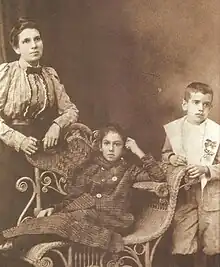
Adolfo Ruiz Cortines was born on 30 December 1889, in the state of Veracruz, into a family of Andalusian descent.[6] His father, Adolfo Ruiz Tejada (1859–1889), regidor of Veracruz during the Porfirio Díaz regime, died two and a half months prior to his birth. His mother was María Cortines de la Cotera (1859–1932).[7] Ruiz's grandfather was José Ruiz y Gómez de la Parra, better known as José Ruiz Parra, a member of the State of Veracruz's first Congress in 1824, who co-wrote the state's constitution. José Ruiz Parra was president of the junta that ruled over the Port of Alvarado during the American Invasion of Veracruz, having to personally sign the surrender of the port in 1847. He was also reputed for organizing fundraisers in favor of the Mexican Army during the Second French Invasion of Mexico, as well as for his deep involvement in the education of the local children. José Ruiz Parra was the maternal grandson of Isidro Gómez de la Parra, subdelegado of the Spanish Crown to the province of Tuxtlas (appointed by Bernaldo de Gálvez, viceroy of the New Spain), and of his wife Dominga Casado de Toro y Tamariz, herself a descendant of the Luna y Arellano family, holders of the hereditary title of Mariscal de Castilla.
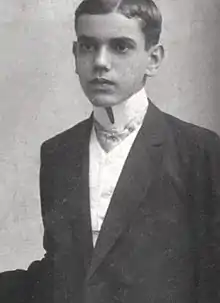
Because of President Ruiz's father, Regidor Adolfo Ruiz Tejada's, premature death, Adolfo was raised and educated by his mother.[1] María Cortines de la Cotera was the daughter of Diego Francisco Cortines y Gutiérrez de Celis (1829, Bielva, Cantabria, Spain), and María Dolores de la Cotera y Calzada (1824, Veracruz, Mexico), whose father was from Peñarrubia, also in Cantabria. His mother taught him to read and write at the age of 3. Later, he entered a school directed by Joaquín Jerónimo Díaz and Florencio Veyro, called Escuela Amiga, but did his secondary educational studies at the Colegio de los Jesuitas, and at the age twelve, he attended the reputed Instituto Veracruzano, famously directed by the poet Salvador Díaz Mirón. Adolfo learned from his mentors about liberalism, a political principle he would apply during his entire political career. In addition, it was at school where he acquired his fanatical interest in baseball. He always wanted to attend a university, but the American Invasion of 1914 forced him to abandon his studies. His first job was as an accounting assistant at a commercial textile company.[1]
Military career
Military career during the Mexican Revolution
In 1909, Ruiz read the book La sucesión presidencial de 1910 (The Presidential Succession of 1910) published that year by Francisco I. Madero, the leader of the opposition against the presidency of General Díaz. This book motivated Ruiz's interest in politics. In 1910, the Mexican Revolution started and he became inspired by several of its main players such as Pascual Orozco and Francisco Villa. Because of this influence, in 1912 at the age of 23, he moved to Mexico City. During his stay in Mexico City, President Francisco I. Madero was assassinated and General Victoriano Huerta took power. Since Ruiz Cortines was opposed to the Huerta government, considered by a broad group of Mexicans as a usurper, he volunteered alongside other former students of the Instituto Veracruzano, under the command of Alfredo Robles, a right hand of the leader of the Constitutionalist faction, General Venustiano Carranza. Robles was in charge of the anti-Huerta forces in the south and center of Mexico.[1] Ruiz Cortines did see military action in the Battle of El Ébano, but his main task was as a bookkeeper and paymaster. In 1920, General Carranza was attempting to flee the country after his defeat by the Sonoran generals (Adolfo de la Huerta, Alvaro Obregón, and Plutarco Elías Calles) who rejected Carranza's attempt to impose his successor, and took with him a large amount of the national treasure (150 million pesos in gold). When the generals captured his train and the national treasure's gold, it was the young and trusted officer, Major Adolfo Ruiz Cortines, who received it and delivered it safely and in presence of a notary to General Adolfo de la Huerta in Mexico City.[8]
Early political career

With his reputation for precise accounting and bookkeeping, a reputation for honesty, and credentials as a veteran of the Mexican Revolution, there were several options open to him in the 1920s. He served in the government's Department of National Statistics. He took classes in statistics from Daniel Cosío Villegas, who was then a young teacher and later an important historian of Mexico. Ruiz Cortines argued in publications that the Department of National Statistics should be an autonomous agency.[9]

In 1935 during the presidency of Lázaro Cárdenas, Ruiz Cortines's political career began at age 45, as the director in charge of Mexico City. It was during that time that he met Miguel Alemán Valdés, son of a revolutionary soldier, now a young lawyer who would later become president of Mexico (1946–1952). In 1940, Ruiz Cortines managed the presidential campaign of Cárdenas's choice as successor, Manuel Avila Camacho.[10] Miguel Alemán asked Ruiz to join him as his sub-secretary because of their personal friendship. This position gave Ruiz the opportunity to gain influence within the Institutional Revolutionary Party. After several years, the PRI designated him as candidate for governor of Veracruz.[1]
Governor of Veracruz
In December 1944, Adolfo Ruiz Cortines became governor of Veracruz. During his administration, he expanded public education in the state. Some of the institutions he founded were the Technical Studies Institute (Departamento para Estudios Técnicos) which provided people with a practical education that allowed them to improve their quality of life. Furthermore, he founded the Institute of Anthropology and the State Planning Committee, among others. He also modified the local constitution to allow women to participate in the local and municipal elections. He built roads and bridges to develop Veracruz's infrastructure since it was one of the main ports of Mexico at that time.[11]
Secretary of the Interior
In 1948, Alemán Valdés' Secretary of the Interior, Héctor Pérez Martínez, died in office, and Alemán Valdés needed to fill the position.[12] Manuel Ávila Camacho recommended Ruiz Cortines, to which Alemán Valdés agreed.[13][14] It was in this position that Ruiz Cortines distinguished himself and became a contender for the next presidential election.
Presidential nomination and campaign
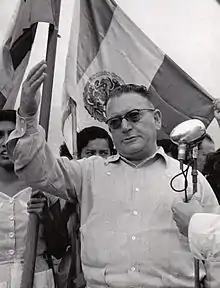
In 1951, Miguel Alemán Valdés expressed his desire to be allowed to serve a second term, but Lázaro Cárdenas and Manuel Ávila Camacho had former president Abelardo L. Rodríguez tell Alemán Valdés that they didn't think, "extension of the presidential term or re-election is convenient for the country."[14] On 14 October 1951, Ruiz Cortines was named candidate for the presidency by the Institutional Revolutionary Party (PRI) by the incumbent president, as had become practice.[15] The PRI was the dominant party and Ruiz Cortines's electoral victory was entirely expected.
Ruiz Cortines is believed to have been chosen due to his more bland image in contrast to Alemán's more colorful personality, and was not seen as divisive to differin sectors of the PRI. Reportedly, Ruiz Cortines accepted the nomination, but he "apparently did not seek it and certainly did not intrigue to secure it." However, by September, Ruiz Cortines' base of support within the party had grown considerably, and included many young senators such as Adolfo López Mateos and Gustavo Díaz Ordaz.[16] His campaign began on October 14, 1951, with his slogan being "austerity and work."[17] In one of his first speaking events during his campaign, he stated to around 20,000 women in attendance, "If the vote favors us in the next elections, we intend to initiate before the Chambers the necessary legal reforms so that women enjoy the same political rights as men," a campaign promise he would later fulfill with an amendment to Article 34 of the Constitution.[18]
General Miguel Henríquez Guzmán, formerly of the PRI, who had twice before attempted to secure the party's presidential nomination,[19] was the candidate of the Federation of the Mexican People's Parties.[20] His support was in largely urban areas, and included Cárdenas supporters alienated during Alemán Valdés' presidency, established military men, and members of the middle class who desired a multi-party democracy.[21]
The National Action Party, eventually the PRI's largest political opposition party, first participated in this election, nominating Efraín González Luna.[22]
Vicente Lombardo Toledano was the Popular Socialist Party's candidate.[23]
The day after the election, Henríquez Guzmán's supporters gathered in the Alameda Central park in Mexico City to celebrate his "victory," although the results had not been announced yet. They were attacked by the police and army troops, with dozens being killed and wounded, and around 500 arrested.[21]
When the results were announced, it was revealed that Ruiz Cortines won, with 74.31% of the popular vote (2, 713,419 votes). Henríquez Guzmán won 15.87% (579,745 votes), González Luna won 7.82% (285,555 votes), and Lombardo Toledano won 1.98% (72,482 votes).[24][25]
President of Mexico
Inauguration
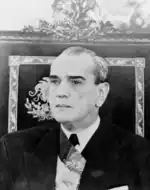
On 1 December 1952, he assumed the presidency of the republic.[26] In his inaugural address, Ruiz Cortines pledged that fighting corruption in the government and in business would be key aspects of his administration,[27] and that he would continue to maintain close relations with the United States.[28]
Administration
| Government of Adolfo Ruiz Cortines | ||
|---|---|---|
| Office | Name | Term |
| Foreign Affairs | Luis Padilla Nervo | 1 December 1952 – 30 November 1958 |
| Public Education | Jaime Torres Bodet | 1 December 1952 – 30 November 1958 |
| Finance and Public Credit | Antonio Carrillo Flores | 1 December 1952 – 30 November 1958 |
| National Defense | Matías Ramos | 1 December 1952 – 30 November 1958 |
| National Assets | José López Lira | 1 December 1952 – 30 November 1958 |
| Economy | Gilberto Loyo | 1 December 1952 – 30 November 1958 |
| Labor and Social Welfare | Adolfo López Mateos | 1 December 1952 – 17 November 1957 |
| Salomón González Blanco | 17 November 1957 – 30 November 1958 | |
| Health | Ignacio Morones Prieto | 1 December 1952 –30 November 1958 |
Ruiz Cortines modified the law to promote responsibility and honesty among public servants to combat increasing amounts of corruption. He created a law that forced public servants to declare their assets before beginning to work in the government, including himself.[29] Ruiz Cortines's purpose was to compare the public servants' fortune before and after their participation in public charges to combat illicit enrichment and corruption.[11]
Domestic politics
After the corruption scandals of the Alemán years, he wanted to give a new image to the government and re-establish its credibility.[30] His credo was "austerity and moralization". He prosecuted several of Alemán's political and business associates who had enriched themselves during the previous administration.[31][32] He suspended all government contracts in 1953 to cut waste and to root out corruption.[33]
He exercised tight control of public expenditure, supported the construction of roads, railways, dams, schools and hospitals. He also implemented a plan called "March to the Sea", which had the aim of shifting population from the highlands to the coast, and making better use and development of marine and coastal resources. Under this program, malaria was eradicated. He created the Rural Social Welfare Program to improve the living conditions of the rural population and encouraged land distribution. Large foreign estates were expropriated. Furthermore, he implemented the Farm Security program to protect farmers from natural disasters.[11]
At the beginning of his term, President Ruiz Cortines sent a bill to amend Article 34 of the Constitution to grant women equal political rights with men, which granted the vote to Mexican women.[30] To promote measures to meet the need for homes, he created the National Housing Institute. He gave a stimulus to industry, particularly small- and medium-sized, and laid the foundation for the development of the petrochemical industry and promoted the creation of jobs.[11]
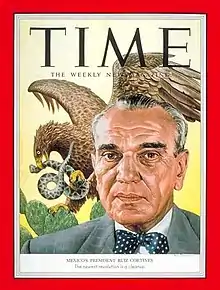
In response to the technical advances in the field of nuclear energy, and considering that Mexico could not remain unaffected by this development, he created the National Nuclear Energy Commission. Primary and secondary education were boosted greatly. He specially supported the polytechnic university. Ruiz Cortines equipped the facilities of the National Autonomous University of Mexico (UNAM) and began subsidies to support universities through the republic.[11]
Another primary goal of his government was to improve the health of men and women in Mexico. Therefore, he fought malnutrition among children and promoted an immunization campaign.[11] Ruiz Cortines turned his attention to social problems and imposed an era of austerity on the Mexican government.
Ruiz Cortines's government decided to reduce public spending, to consolidate public finances and fight inflation.[30] These policies led to macroeconomic stability, and contributed to the Mexican economy high growth rates during the 1950s. For first time in many years the Mexican government generated a budget surplus. However, following Ruiz Cortines's 1953 suspension of all government contracts, construction companies were weakened, the national output fell, the foreign trade deficit rose by a third, and almost all employers announced layoffs. [33] He chose to shift away from austerity and reoriented his policy towards boosting production,[11] and announced a record $400 million spending plan to pump into public works projects.[33] In April 1954, in the so-called "crisis de la Semana Santa", he had to devaluate the peso from $8.65 per dollar to $12.50 per dollar.[35] Despite the devaluation, in 1955, Mexico's dollar reserves were roughly equivalent to $305 million, the highest since he took office.[36] In December 1955, in a push for a balanced budget, Ruiz Cortines announced the next year's budget, 6,696,374,000 pesos ($535,709,920 in 1955), which was an increase from the previous year, but was still considered somewhat conservative given Mexico's rapidly growing economy.[37]
By the end of his term in 1958, he had faced three social-political conflicts with peasants, teachers and the labor union of the railroad workers.[38]
Mexico's real national income had increased 7% halfway through 1954, and 10% halfway through 1955. In 1954, Mexico's electric power output increased 10%, manufacturing increased 9.8%, and crude-oil production increased 15%. By 1955, Mexico's crop, coffee, and cotton production and yield had increased 20% since the start of Ruiz Cortines's term, at that point an all-time high for Mexico.[36]
Earthquake of 1957
On July 28, 1957,[39] an earthquake with an epicenter in the state of Guerrero shook Mexico City for about 90 seconds.[40] It measured 7.7 on the Richter scale,[39][41] and left 160 people dead. Ruiz Cortines was in his office in the national palace at the time.[40]
Foreign relations
During Ruiz' Cortines's term, Mexico had cold diplomatic relationships with the United States because Ruiz Cortines refused to make any agreements that committed Mexico to participate in international wars. During his term, Ruiz Cortines completed the construction of projects like Falcon Dam, built with a 58.6% equity and 41.4% Mexican American funds. In 1956, Ruiz Cortines attended a meeting with US President Dwight Eisenhower and Canadian Prime Minister Louis St. Laurent of Canada. During the meeting, the leaders discussed immigration issues, economic cooperation, civil aviation and illegal fishing in coastal areas. In general, President Ruiz Cortines's foreign policy was conservative and respectful of the sovereignty of other nations.[42] His administration was looking for a closer relationship with Latin America and sought the integration into the institutional system of Latin America, the Organization of American States (OAS).[43] In the Conference of Caracas, held in 1954, Mexico failed in its attempt to defend the self-determination of the people.[44]
In total, Ruiz Cortines only made three foreign visits during his term, which was deliberately a small amount, as he did not want to waste money on planes or waste time on boats.[45]

In 1935, under Lázaro Cárdenas, Mexico was one of only five countries to condemn Fascist Italy's invasion of Ethiopia (then the Ethiopian Empire or Abyssinia) during the Second Italo-Ethiopian War.[46][47] In 1953, Ruiz Cortines invited Haile Selassie, the Emperor of Ethiopia, to visit Mexico, who used the opportunity to thank Mexico for condemning the invasion against him.[46] In 1955, Selassie accepted the invitation, and inaugurated at plaque in Mexico City with his country's name on it. He inaugurated a plaque with Mexico's name on it in his country's capital in 1958.[47]
1958 presidential succession
In 1957, Ruiz Cortines, as was tradition, was to announce the PRI's next presidential candidate. Taking imput from ex-presidents Lázaro Cárdenas and Miguel Alemán Valdés, each symbolizing the left and right sectors of the PRI respectively, he announced his hard-working but little-known Labor Minister Adolfo López Mateos as the next candidate, with international observers seeing López Mateos as the sure winner despite his relative obscurity.[48] López Mateos eventually won the election with 90% of the popular vote.[49]
Post-presidency

On 1 December 1958, Ruiz handed over power to his successor López Mateos,[50][51] and then he retired from public life almost altogether. In 1964, he attended the inauguration of López Mateos' successor, President Gustavo Díaz Ordaz.[52]
In his last days, his friend Manuel Caldelas García, a politician whom he had known in his youth, began living with him at his home in Veracruz. Caldelas helped with household chores and took care of the former president. On the afternoon of 3 December 1973, the health status of Ruiz Cortines became critical. Dr. Mario Díaz Tejeda went to the home to treat the condition of the former president. When the drugs took effect on him, Ruiz Cortines fell asleep. At 9:05 am on Monday, 3 December 1973, Adolfo Tomás Ruiz Cortines died at 82 years of age, a victim of heart failure caused by arteriosclerosis.[42][2]
Personal life
In 1915 he married his first wife, Lucía Carrillo Guitiérrez, the daughter of Veracruz's then-governor, Lauro Carrillo. Ruiz Cortines and Lucía later divorced.[53]
He married his second wife, an old girlfriend named María de Dolores Izaguirre, in 1941, who would serve as his First Lady.[53]
References
- Fernández, Íñigo (2008). México Contemporáneo I [Contemporary history of Mexico] (in Spanish). Vol. 1. México, MX: In Pearson Educación. pp. 322–394 [338].
- "Adolfo Ruiz Cortines Dead At 82; Was Resident Of Mexico '52-'58". The New York Times. 4 December 1973. Retrieved 16 August 2023.
- "En Veracruz se comparte el legado de honradez y probidad del expresidente Adolfo Ruiz Cortines: Buganza" (in Spanish). RTV Radiotelevisión de Veracruz. 30 December 2014. Retrieved 20 September 2023.
- Varios. Guia. Retrieved 11 September 2018.
- Rodríguez Prats 2017, p. 27
- Krauze 1999, p. 9
- Rodríguez Prats 2017, p. 34
- Krauze 1997, pp. 605–606.
- Krauze 1997, p. 606.
- Krauze 1997, pp. 606–607.
- Krauze 1999, pp. 90, 100, 178
- Rodríguez Prats 2017, p. 77
- Krauze 1999, p. 26
- Aguilar Plata & García 2006, p. 78
- Aguilar Plata & García 2006, p. 82
- Navarro 2010, p. 212
- Aguilar Casas & Serrano Álvarez 2012, p. 220
- "Ruiz Cortines, el verdadero transformador" (in Spanish). Ruiz-Healy Times. 9 March 2022. Retrieved 9 September 2023.
- "Miguel Henríquez Guzmán, Sought To Govern Mexico". The New York Times. 31 August 1972. Retrieved 5 September 2023.
- Aguilar Plata & García 2006, p. 80
- Russell, Philip (2015). The Essential History Of Mexico: From Pre-Conquest to Present. Taylor & Francis. ISBN 9781135017217.
- "Efraín González Luna, 66; Founder Of Mexican Party". The New York Times. 12 September 1964. Retrieved 29 August 2023.
- Aguilar Casas & Serrano Álvarez 2012, p. 221
- Aguilar Plata & García 2006, p. 86
- Carranza Palacios 2004, p. 47
- Aguilar Casas & Serrano Álvarez 2012, p. 223
- "Mexico's New Head Vows To End Graft". The New York Times. 2 December 1952. Retrieved 16 August 2023.
- "MEXICO: Decorous President". Time Magazine. 8 December 1952. Retrieved 21 August 2023.
- "Mexican President Acts To End Graft". The New York Times. 29 December 1952. Retrieved 16 August 2023.
- Delgado de Cantú 2003, p. 286.
- "Monoply Reform Pushed In Mexico". The New York Times. 12 July 1953. Retrieved 22 August 2023.
- "MEXICO: The Nation Is Ashamed". Time Magazine. 27 July 1953. Retrieved 22 August 2023.
- "Mexico: Priming The Pump". Time Magazine. 29 March 1954. Retrieved 22 August 2023.
- "Presidentes mexicanos en la portada de Time" (in Spanish). El Siglo de Torreón. 13 February 2014. Retrieved 27 August 2023.
- Delgado de Cantú 2003, p. 299.
- "MEXICO: Problems & Progress". Time Magazine. 12 September 1955. Retrieved 21 August 2023.
- "Mexico President Balances Budget". The New York Times. 17 December 1955. Retrieved 29 August 2023.
- Delgado de Cantú 2003, pp. 290–292.
- Aguilar Casas & Serrano Álvarez 2012, p. 238
- Izquierdo, Ignacio (13 April 2023). "Cómo fue el terremoto que sacudió México durante el sexenio de Adolfo Ruiz Cortines" (in Spanish). Infobae. Retrieved 10 October 2023.
- "El sismo de 1957 que dejó al descubierto diversos problemas de construcción en el centro de la capital" (in Spanish). Gobierno de México. 28 July 2021. Retrieved 10 October 2023.
- Bermúdez, Gilberto (2006). "Adolfo Ruiz Cortines" [Adolfo Ruiz Cortines] (in Spanish). México: Gobierno del Estado de Veracruz. Archived from the original on 26 March 2009. Retrieved 22 October 2010.
- Delgado de Cantú 2003, p. 293.
- Delgado de Cantú 2003, p. 295.
- Loera, Martha Eva (29 November 2016). "Presentan en FIL nueva Biografía de Adolfo Ruiz Cortines" (in Spanish). Universidad de Guadalajara. Retrieved 9 September 2023.
- del Río, Salvador (5 April 2016). "Episodios de soberanía" (in Spanish). El Sol de México. Retrieved 21 October 2023.
- Bribiesca, Erika; Santos Gallagher, Hugo (21 April 2017). "El emperador que inauguró un pedacito de África en México" (in Spanish). El Universal. Retrieved 24 October 2023.
- "MEXICO: The Next President". Time Magazine. 18 November 1957. Retrieved 21 August 2023.
- Carranza Palacios 2004, p. 53
- "Cool-Headed Mexican; Adolfo López Mateos". The New York Times. 2 December 1958. Retrieved 28 August 2023.
- Aguilar Casas & Serrano Álvarez 2012, p. 245
- "Díaz Is Sworn In As Mexico's Head". The New York Times. 2 December 1964. Retrieved 28 August 2023.
- Cabeza de Vaca, María Luisa (4 October 2016). "El segundo aire de los presidentes" (in Spanish). Cuna de Grillos. Retrieved 24 September 2023.
Bibliography
- Aguilar Casas, Elsa; Serrano Álvarez, Pablo (2012). Martínez Ocampo, Lourdes (ed.). Posrevolucionario y estabilidad. Cronología (1917-1967) (PDF). Instituto Nacional de Estudios Históricos de las Revoluciones de México. ISBN 978-607-7916-65-9.
- Aguilar Plata, Áurea Blanca; García, Carola (2006). Medios de comunicación: del destrape a las campañas electorale, 1934-1982 (in Spanish). Universidad Nacional Autónoma de México. ISBN 970-722-577-7.
- Carranza Palacios, José Antonio (2004). 100 años de educación en México, 1900-2000 (in Spanish). Limusa. ISBN 968-18-6439-5.
- Delgado de Cantú, Gloria M. (2003). Historia de México II. Pearson Educación.
- Krauze, Enrique (1997). Mexico: Biography of Power. New York: HarperCollins. ISBN 0-06-016325-9.
- Krauze, Enrique (1999). "El sexenio de Ruiz Cortines" [Ruiz Cortines Term] (in Spanish). México, MX: Editorial Clío. ISBN 9789706630131.
- Navarro, Aaron W. (2010). Political Intelligence and the Creation of Modern Mexico, 1938-1954. Pennsylvania State University Press. ISBN 9780271037059.
- Rodríguez Prats, Juan José (2017). Adolfo Ruiz Cortines: El Poder Presidencial (in Spanish) (4 ed.). Miguel Angel Porrúa Grupo Editorial. ISBN 6075241256.
- (in Spanish) Mexican government biography
- Online biography
Further reading
- Aguilar de la Parra, Hesiquio (2012). Adolfo Ruiz Cortines: El Poder Con Honradez (in Spanish). SITESA. ISBN 9786077744443.
- Camp,Roderic A. Mexican Political Biographies. Tucson, Arizona: University of Arizona, 1982.
- Luna Elizarrarás, Sara Minerva. "Enriquecimiento Y Legitimidad Presidencial: Discusión Sobre Identidades Masculinas Durante La Campaña Moralizadora De Adolfo Ruiz Cortines." Historia Mexicana, vol. 63, no. 3 (251), 2014, pp. 1377–1420. JSTOR, www.jstor.org/stable/24369004.
- Pellicer De Brody, Olga Pellicer and José Luis Reyna. "Las Modalidades Ruizcortinistas Para Mantener La Estabilidad Politica." Historia De La Revolución Mexicana, Período 1952–1960: El Afianzamiento De La Estabilidad Política, and Jose Luis Reyna, 1st ed., vol. 22, Colegio De Mexico, México, D. F., 1978, pp. 13–72. JSTOR, www.jstor.org/stable/j.ctv233pb3.5.
External links
- (in Spanish) Mexican government biography
